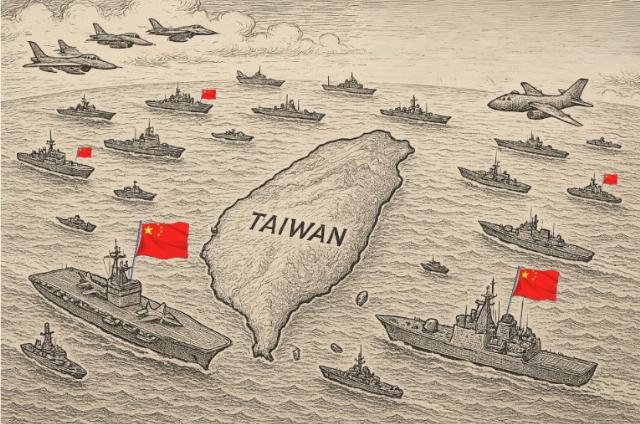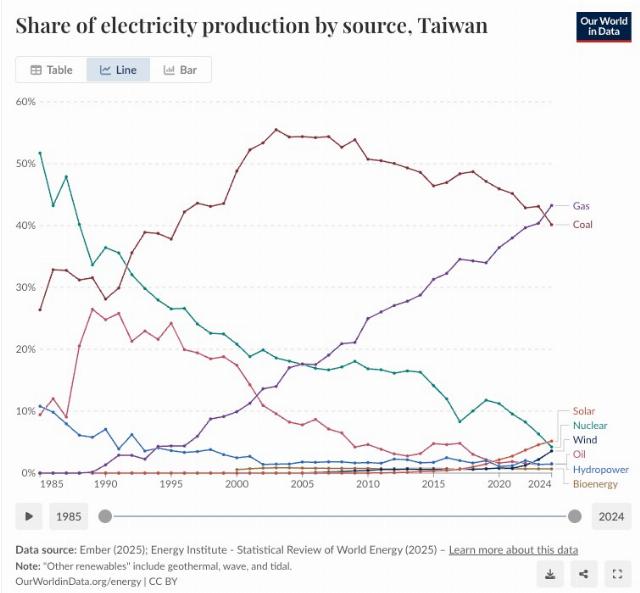


If Communist China intends to seize control of Taiwan, invasion is the most expensive and dangerous route. Better for them might be a naval blockade of the island nation. So says a recent wargame study by Washington-based Center for Strategic and International Studies (CSIS), Lights Out? Wargaming a Chinese Blockade of Taiwan by Mark F. Cancian, Matthew F. Cancian, and Eric Heginbotham.
In the worst-case outcome modeled, wargaming American attempts to bust the blockade could result in 20,000+ American casualties and the loss of two nuclear-powered carriers and nine nuclear submarines, plus hundreds of warplanes. That’s just to break the blockade and does not count escalation into a likely wider war between China and America with its allies. Moreover, the study finds no easy “off-ramps” from the escalation progression towards a wider war other than the capitulation of Taiwan.

Image created using AI.
As the study’s title—“Lights Out?”—suggests, the pinch point for Taiwan would be having electricity production cut to 20% of normal within 8 to 12 weeks from the effective start of the blockade. With all their fossil fuels imported and with the recent closure of their last nuclear power plant, remaining supplies would be largely from non-dispatchable renewables and minor hydroelectric.
Industrial activity would cease with only enough power for vital infrastructure like waterworks, hospitals, and electric rail. Rice is stockpiled and can be delivered, “Berlin airlift” style, but there’d be no electricity for the rice cookers.
To set the stage, the study provides an interesting background on blockades, such as the history and effectiveness of blockades, and some legal niceties, like how a quarantine and a blockade differ. As a wargame, many initial assumptions are made, but the most important are the four stages of escalation of a blockade between China and Taiwan and its allies, specifically, the US and Japan.
Once the Chinese Communist Party leadership makes a decision to blockade, a notice to mariners is broadcast, and inbound ships are stopped and boarded, and if necessary, seized by force of arms. Of course, Taiwan can’t have that, so at some point, it fights back against the intercepting Chinese warships. The third level of military action is when other countries support Taiwanese blockade runners in its local territorial waters with their own warships.
At the top level of this analysis is where the fighting expands to international waters, signifying regional naval warfare by China against Taiwan, the US, and other allies like Japan. Beyond the fourth level, and not analyzed, comes general war, where the US begins direct attacks against the Chinese mainland.
Electricity is the weak spot for Taiwan as a highly industrialized country. Its per capita electric consumption is on the level with the US and South Korea and considerably higher than for Japan. While coal and oil have large quantities in normal process inventories, they can and should be stockpiled. However, Taiwan’s predominant fuel source, liquified natural gas (LNG,) can’t be stockpiled. Because it is a cryogenic liquid, it essentially eats itself – some of the energy in an LNG tank must be used to maintain it as a liquid, leading to a “use it or lose it” process.

Image from Our World I Data. CC.
Unfortunately, LNG logistics are the most vulnerable to blockade. The maritime community demonstrated this clearly when the Houthis began attacking merchant ships at the mouth of the Red Sea. The owners of LNG tankers immediately diverted to the much longer route around Africa rather than risk attack by a Houthi drone or RPG.
While a coal carrier is essentially a metal can full of rocks with a motor attached and not easy to sink, much less explode, an LNG tanker is full of what Elon Musk calls rocket fuel. Without armor (although well-insulated), the aluminum LNG containers are easily breached. If the contents spilled, a massive conflagration could occur. (You can see illustrations of one company’s LNG carriers here.)
One oversimplification of the wargame is assigning LNG tankers the same fragility under attack as historical data for general merchant ships. Indeed, the shipping community thinks they are far more fragile and vulnerable based on their recent behavior in the Red Sea.
So, with a blockade, LNG goes away as an electric source pretty quickly, maybe in a couple of weeks. Coal piles are eaten, and oil storage tanks drained. Per the simulation, without new supplies running the blockade, the generators shut down, the economy collapses, and the population suffers.
As escalation continues, America and Taiwan organize convoys to run the blockage from Japanese terminals into Taiwan. The sobering news is that, with improved Chinese missiles, the attrition rate for a merchant ship in a convoy approaches 50%. While cash might buy LNG tankers, what sailor would sign on with a 50% chance of incinerating per trip?
The sad part of this story is that the Taiwanese have created their own electrical vulnerability. In 1985, over 50% of the country’s electric production was from nuclear power plants. With the closure of its last operating plant earlier this year, it now has none.
Unlike LNG, a nuclear power plant can easily store an additional year and a half of ready-to-use fuel on-site in existing racks. If need be, a single large military transport can deliver another year and a half’s worth of fuel in a single flight.
A serious American naval response to a blockade would mean American sailors doing what they have volunteered to do—“Go in harm’s way.” With a full-blown but regionally limited naval war, over 20,000 wouldn’t come home.
We could lose two nuclear aircraft carriers and perhaps nine nuclear-powered submarines. These are just the results of professional wargame calculations using a prescribed set of initial conditions. They only assume Japan and the US participate and exclude recently established or re-established American bases in the Philippines, intentionally located to contribute to maintaining our First Island Chain defense.
The irony here is that Taiwanese assumptions of American military support have created a moral hazard: The Taiwanese are allowed to engage in self-defeating behaviors like closing their blockade-resistant nuclear power industry. Taiwan thinks that it can shut its nuclear power plants because American sailors arriving in nuclear-powered warships will protect them and keep the lights on.
The US government needs to make a forceful point to the Taiwanese; namely, that the price of our military protection is Taiwan reopening and expanding its nuclear power plants. As the saying goes, “The Good Lord helps those who help themselves.”
Joseph Somsel is a degreed nuclear engineer with an MBA. He spent many happy years designing and building Taiwan’s last but still unopened nuclear power plant. He is an American citizen now residing in the Philippines.
